Having stopped off last week in Syrah’s spiritual home – the Northern Rhône – in search of the region’s leading wines for the 2015 vintage, this week Wine Lister’s Listed section ventures to Australia, surely Syrah’s most famous home from home. Australian Shiraz might differ stylistically from the Northern Rhône’s finest Syrahs, but the Land Down Under’s foremost brands have certainly managed to establish themselves as a force to be reckoned with on the international fine wine market.
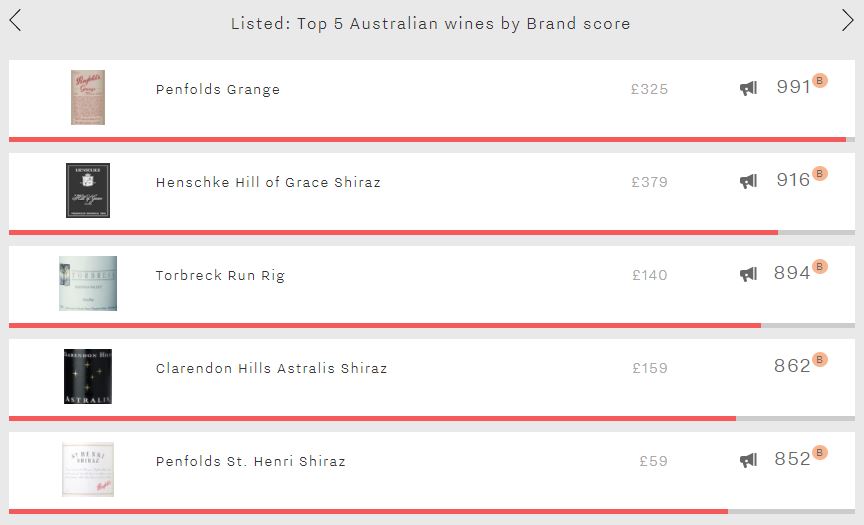
Penfolds’ flagship Grange is Australia’s runaway leader in the Brand category. Its formidable score of 991 is not only 75 points ahead of Australia’s second strongest brand – Henschke Hill of Grace Shiraz – but also nudges ahead of the Northern Rhône’s top brand – Jaboulet Hermitage La Chapelle. Whilst Grange can’t quite match La Chapelle in terms of the number of the world’s top restaurants in which it features (34% vs 43%), establishments in which it does appear list 1.5 times more vintages / formats on average (4.5 vs 3.0). Grange is also considerably more popular than La Chapelle, receiving nearly twice as many searches each month on Wine-Searcher. Within Australia no other wine comes close to its level of brand strength. It is visible in nearly twice as many restaurants as the group’s next-best wine in the criterion – Henschke Hill of Grace Shiraz – and is searched for almost five times more frequently than the second-most popular wine of the five – Penfolds St. Henri Shiraz. Last year’s release of g3, a blend of 2008, 2012, and (the as yet unreleased) 2014 Grange will only serve to secure Grange’s standing as Australia’s top brand. Click here to see all of Grange’s vintages. Confirming Penfolds as Australia’s most prestigious producer, the St. Henri Shiraz bookends the top five with a score of 852.
Other than Grange, the only Australian wine to enjoy a Brand score above the 900-point mark – and thus making the “strongest” band on Wine Lister’s 1,000-point scale – is Henschke Hill of Grace Shiraz (916). As previously mentioned, Eden Valley’s leading light achieves the group’s second-best level of restaurant presence. It is also the third-most popular wine of the five, receiving 4,107 searches each month on average and, notably, is by far the most expensive of the group.
The two remaining spots are filled by Torbreck Run Rig and Clarendon Hills Astralis Shiraz (894 and 862 respectively). Whilst they receive a very similar number of searches each month, Torbreck Run Rig edges ahead thanks to superior restaurant presence (17% vs 11%) – presumably in part due to producing over twice as many bottles each year as Clarendon Hills Astralis.
For some, Piedmont is virtually synonymous with the DOCG appellation of Barolo. While wines from this famous appellation rank amongst the very best on Wine Lister, its understated sibling Barbaresco also holds its own, as we discover looking at the top five Barbarescos by Wine Lister score below.
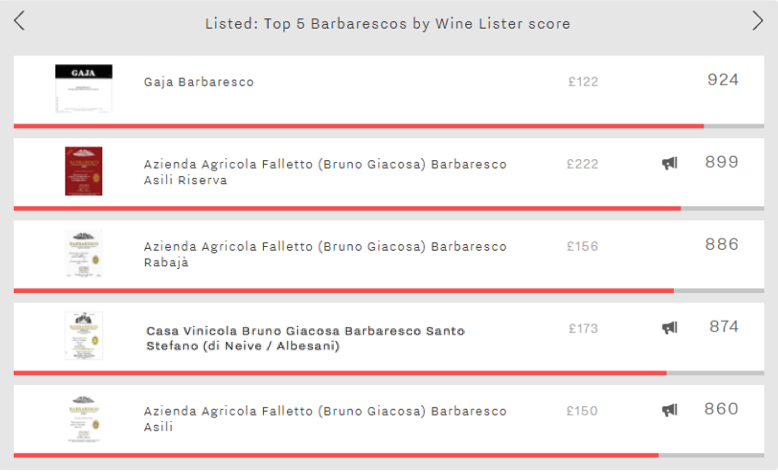
With an overall score of 924, Gaja’s Barbaresco takes the top spot. It leads thanks to its excellent Brand score (977), over 120 points ahead of Barbaresco’s second-strongest brand. As the only one of the group with brand as its strongest suit, Gaja’s Barbaresco is present in 33% of the world’s top restaurants, has the widest range of vintages and formats on each wine list, and receives over five times more searches each month on Wine-Searcher than the second-most popular wine of the group. Consequently, the wine has the joint-highest Brand score of all Piedmont wines – alongside Giacomo Conterno’s Barolo Monfortino Riserva.
Numbers two to five on the list share the same legendary producer. The recently departed Bruno Giacosa has left behind him a formidable legacy, reflected in his four-fold appearance in this top five. The domaine Azienda Agricola Falleto’s and Giacosa’s negotiant arm expressions of Barbaresco excel across all three categories that make up their overall Wine Lister score.
Azienda Agricola Falletto’s Asili Riserva has the best Economics score of all Barbarescos (967), with a compound annual growth rate (CAGR) of 18.5%. It is also the most expensive at £222 per bottle, and most traded of the five.
Giacosa’s Barbaresco Rabajà takes third place, but holds the best Quality score (963) and best long-term price performance (27.0%). The former is reflected in the wine’s impressive average ageing potential of 22 years, five years longer than the Asili Riserva. Indeed, Rabajà 2004, which achieves an outstanding Quality score of 993, has only recently entered its drinking window, and will be drinking well until 2034.
Fourth and fifth spots are taken by Giacosa’s Barbaresco Santo Stefano (di Nieve / Albesani) and Barbaresco Asili. They display very similar profiles, each performing best in the Economics category, followed by Quality, and then Brand. Both wines still rank as “very strong” on the Wine Lister 1000-point scale, with overall scores of 874 and 860 respectively.
This is a poignant week for Azienda Agricola Falletto, with many of the great estate’s wines being released for the first time since the passing of Bruno Giacosa.
After a distinctly Burgundian start to 2018, we are ringing the changes this week to look at some of our most improved Brand scores, with Champagne dominating.
Alongside presence in the world’s best restaurants, Wine Lister’s Brand score measures a wine’s online popularity – as indicated by the number of searches received on Wine Searcher – as a marker of real consumer demand.
The search frequency data for December is in, and it is no surprise that searches in Champagne increased significantly leading up to the Christmas period.
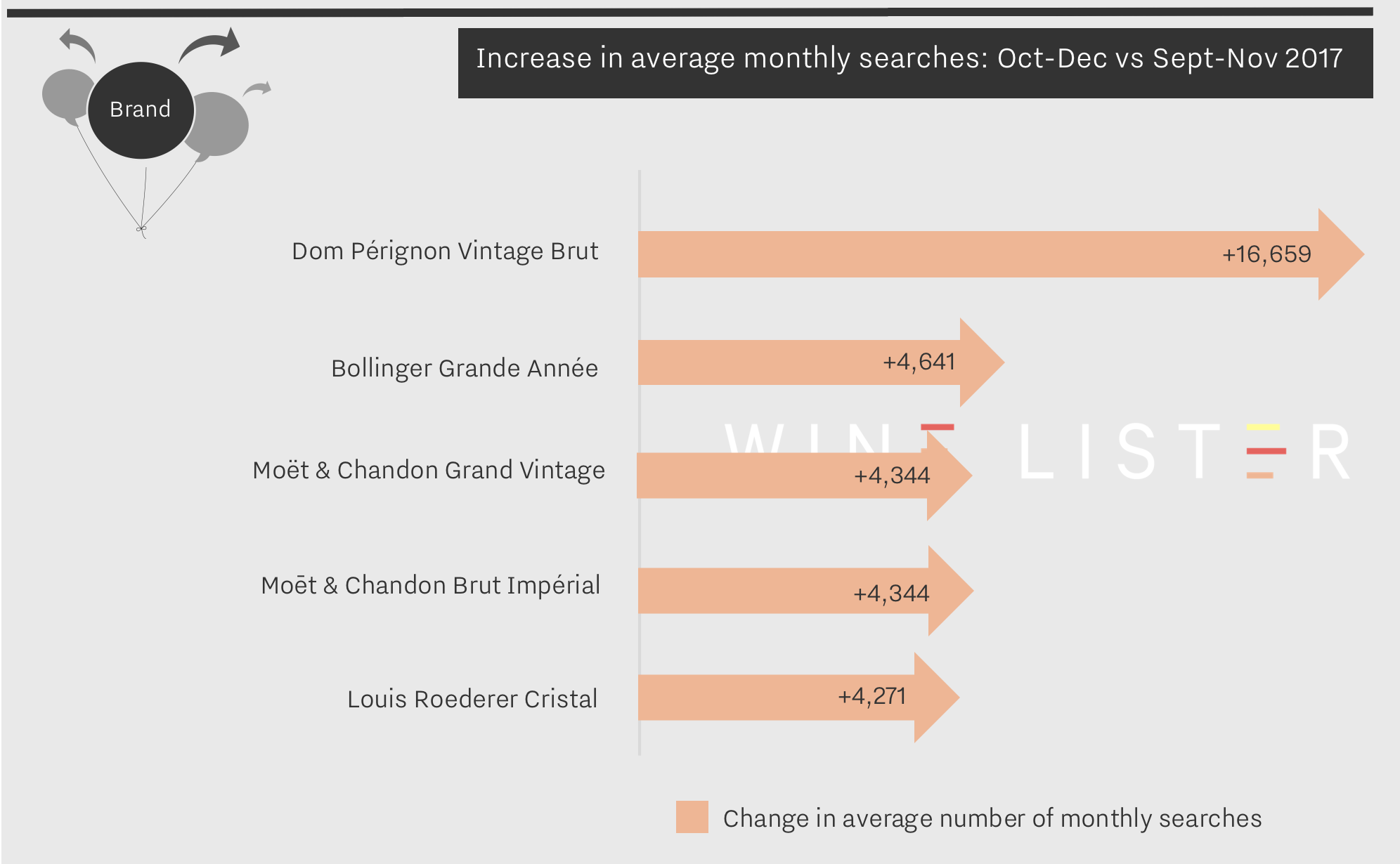
During arguably the busiest period of the year for searching and purchasing wines, these five wines gained between 20% and 77% increase in search frequency. The appearance of Dom Pérignon Vintage Brut at the top of search frequency lists is a shock to no one considering its position as one of the most searched-for wines of all time. Indeed, it consistently held the number one search spot from July to September last year. The Christmas influence still managed to add 16,659 online searches, allowing this almighty brand to achieve Wine Lister’s first ever perfect Brand score (1000)!
Next on the list is Bollinger Grande Année. Its impressive 77% increase in search frequency at the end of last year can also be attributed to the festive season, but may also have been boosted by the release of the 2007 vintage earlier in the year. Bollinger’s new Brand score is up 16 points on the previous quarter at 975.
Our next two appearances hail from the same owner as the first, Champagne divinity LVMH. Moët & Chandon, often considered the definitive Champagne brand holds not one, but two spots in the top five most searched for wines of the last three months. Moët & Chandon Grand Vintage is perhaps a classic Christmas choice, but the appearance of a non-vintage cuvee, the Moët & Chandon Brut Impérial is testament to the power of the Moët & Chandon brand. Each earned an increase in search frequency of 33%, bringing Brand scores to 987 and 938 respectively.
Last but not least, Louis Roederer Cristal takes fifth place with a search frequency increase of 20%. While achieving a fractional increase in searches (4,271) compared with Dom Pérignon, its presence in 54% of restaurants and consistent high quality (Quality score 970) makes Cristal an all-round achiever, and therefore a choice that’s not just for Christmas.
Champagne’s Brand prowess is clear, but these five are the shining stars of their region. It is interesting to note that the sixth most searched-for wine on our most recent list is in fact not a Champagne at all, but Château Margaux (Brand score 998).
Mention New Zealand, and the first thing that springs to mind will most likely be rugby. The All Blacks are not just the world’s best team, but the foremost brand in rugby. In wine terms, they are the left bank first growths; the team that even people who don’t follow rugby will recognise. Whilst peerless with the oval ball, when it comes to vinous competition New Zealand can’t compete with its Old World counterparts in terms of brand strength. However, as this week’s top five shows, New Zealand’s top brands definitely shouldn’t be discounted.
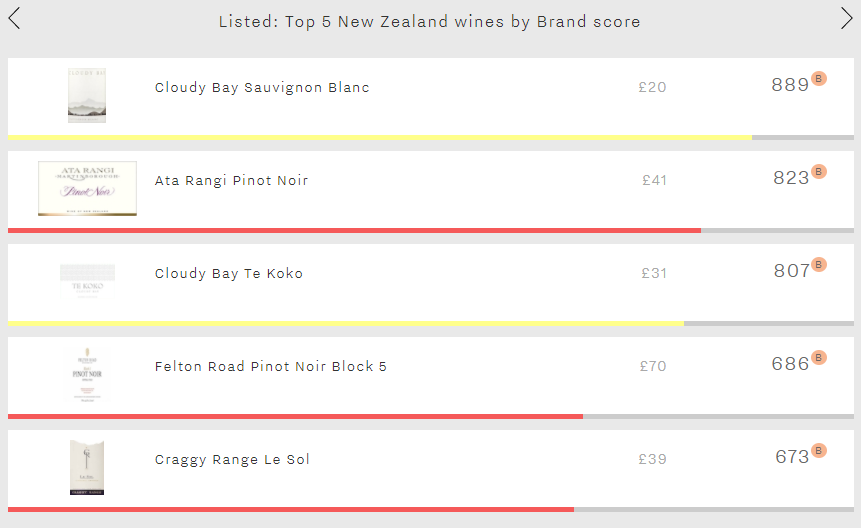
Cloudy Bay fills two of the five spots with its straight Sauvignon Blanc and Te Koko Sauvignon Blanc. With a very strong score of 889 – putting it ahead of the likes of Haut-Brion Blanc – the straight Sauvignon Blanc dominates the rest of the five across both of Wine Lister’s brand criteria. It receives 56% more searches each month on Wine-Searcher than Ata Rangi Pinot Noir (the group’s second-most popular wine). Te Koko – New Zealand’s third-strongest brand (807) – displays a similar profile to the straight Sauvignon Blanc. Its brand is its strongest facet, comfortably outperforming its Quality and Economics scores (614 and 308 respectively).
Whilst Sauvignon Blanc is New Zealand’s foremost white grape, its most prestigious reds are Pinot Noirs, with Ata Rangi’s offering and Felton Road’s Block 5 both appearing in the top five. Ata Rangi is by far New Zealand’s strongest red brand (823). It is the country’s most visible red in the world’s top dining establishments (11%), and also the most popular with consumers, receiving three times as many searches each month as the Felton Road. Whilst it appears in just 7% of top restaurants, Felton Road Block 5 enjoys the group’s best vertical presence, with two vintages / formats offered on average per list. It is also the most expensive of the five. Incidentally, the two Pinot Noirs comfortably achieve the group’s best Quality scores and are the only two with scores above 800 in the category.
Proving that New Zealand isn’t all Sauvignon Blanc and Pinot Noir, Le Sol – Craggy Range’s Syrah – completes the five, with a Brand score of 673.
Today marks the close of a busy week of Burgundy 2016 en primeur tastings, with offer prices largely stable on 2015 despite tiny volumes, thanks to the more generous 2017 in the wings. However, prices have been escalating in the secondary market for several years now, with eight of the region’s top wines averaging more than £3,000 per bottle). Eyewatering, yes, but as illustrated in our recently published study, the majority of the region’s top wines are priced between £100 and £500.
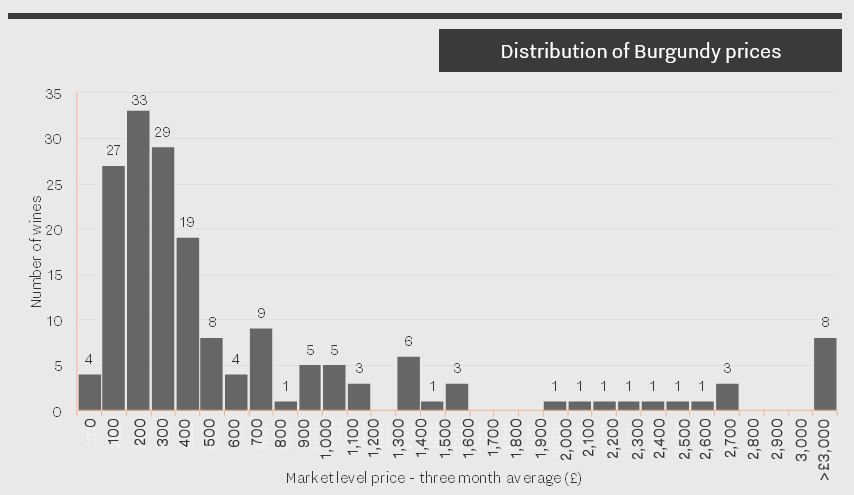
To mark this week’s Burgundy en primeur tastings, the latest Listed section picks out the top five red Burgundies priced under £300 per bottle by Wine Lister score. With an outstanding average score of 913 – putting them amongst the very strongest on Wine Lister – and four of the five achieving Buzz Brand status, these wines are worth the price tag.
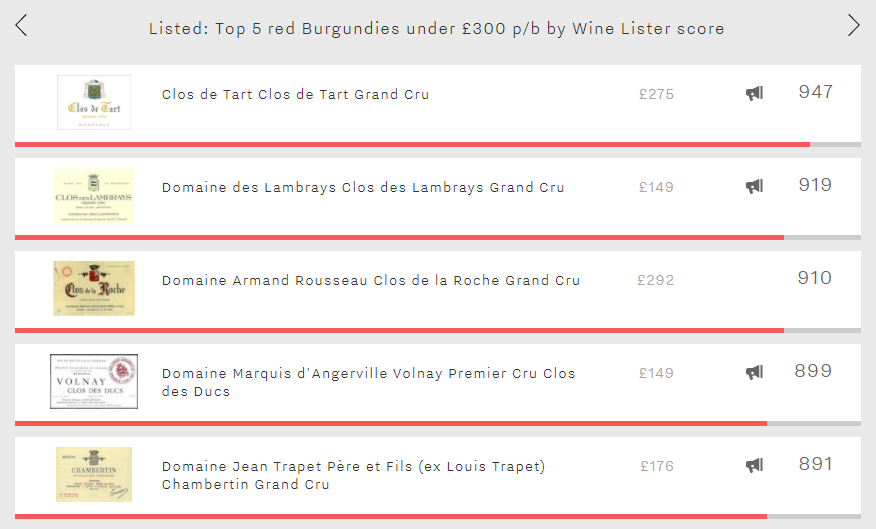
Leading the way is Grand Cru monopole Clos de Tart with a score of 947. Recently acquired by Artemis Domaines – Latour owner François Pinault’s holding company – it achieves the best Brand and Economics scores of the group (956 and 964 respectively), and is just pipped into second place in the Quality category by Trapet Père et Fils Chambertin Grand Cru (932 vs 940). Its price has increased 9% over the past six months, and now at £275, it looks like it won’t qualify for this group much longer!
Next comes Domaine des Lambrays Clos des Lambrays – part of LVMH’s portfolio since 2014 – with a score of 919. Alongside Marquis d’Angerville Volnay Premier Cru Clos des Ducs, this is the cheapest (or least expensive) of the group (c.£150 each). It enjoys its best score in the Brand category, with the group’s highest level of restaurant presence (25%), and the second-best average monthly online search frequency (5,079).
In third place is Rousseau’s Clos de la Roche Grand Cru with a score of 910. At almost £300 per bottle, it is the most expensive of the group, contributing to its boasting the best score in the Economics category (937). It is also partner critic Jeannie Cho Lee’s favourite wine of the group; she awards it a score of 95/100 on average.
Dropping just below the 900-point mark are Marquis d’Angerville Volnay Premier Cru Clos des Ducs and Trapet Père et Fils Chambertin Grand Cru (899 and 891 points respectively). They display very different profiles. The latter leads the Quality category, with the former lagging 60 points behind (still with a very strong score of 879). However,Trapet’s Chambertin struggles in other categories, with the group’s lowest scores for Brand and Economics (867 and 823). Meanwhile, thanks to the group’s strongest long and short-term growth rates, Marquis d’Angerville’s Volnay Clos des Ducs enjoys an excellent Economics score (939) – the second-best of the five.
If you’d like to discover more about Burgundy and its top wines, then click here if you are a subscriber to view the full regional study, or here to see a preview if you haven’t yet subscribed.
Following on from our recent blog in which we looked at the five wines that enjoyed the greatest absolute increase in online search frequency during November, we thought it would be interesting to look at the five wines whose improved popularity had the biggest impact on their Brand score. This throws up some less obvious candidates.
Alongside presence in the world’s best restaurants, Wine Lister’s Brand score measures a wine’s online popularity – as indicated by the number of searches received on Wine Searcher – as a marker of real consumer demand. The five wines below do not come close to rivalling the phenomenal popularity of the first growths and company whose search frequency increased the most in absolute terms in November. However, the relative change in their online search frequency led to some significant improvements in their Brand scores.
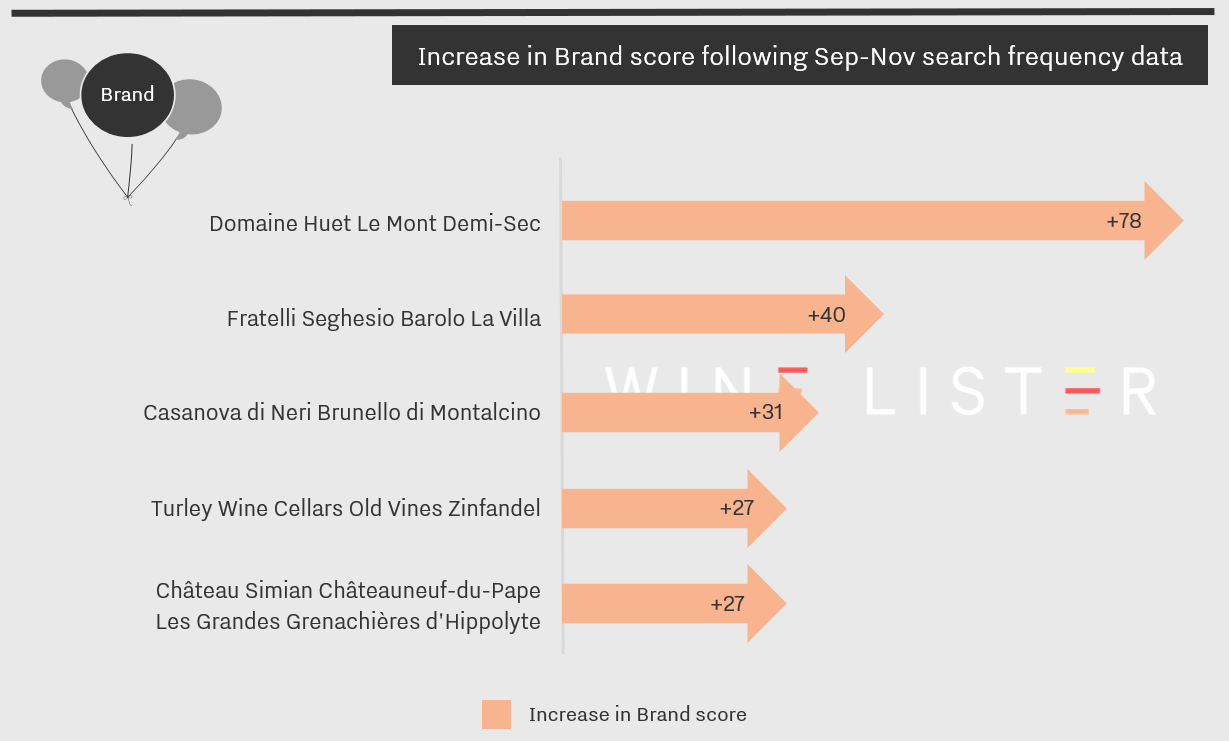
Whilst each of the five experienced an increase of at least 44% in their online search frequency, Domaine Huet Le Mont Demi-Sec’s surged 147% during November, resulting in a whopping 78-point gain in its Brand score (now 765), tipping it into the very strong category on Wine Lister’s 1,000 point scale. Its sharp increase in online popularity might be the result of the 2016 vintage being named the sixth best wine in the world by Wine Spectator last month. Whilst the 2016’s Wine Lister Quality score (917) can’t quite match the performance of two of Domaine Huet’s sweeter cuvées for the vintage, it appears that it is a brand on the up.
Next comes a duo of Italian reds – Fratelli Seghesio Barolo La Villa and Casanova di Neri Brunello di Montalcino. Starting from a low base of just 243 searches each month, the Piedmontese red’s search frequency leapt 63% to 396, resulting in a 40-point increase in its Brand score (506). In stark contrast, Casanova di Neri’s straight Brunello already benefitted from a high level of online popularity, previously receiving 1,791 searches each month on average. It’s 72% increase in search frequency – again presumably thanks to the 2012 vintage’s fourth spot in Wine Spectator’s top 100 wines – has resulted in a new Brand score of 799, the highest of the group.
Last but not least, Turley Wine Cellars Old Vines Zinfandel and Château Simian Châteauneuf-du-Pape Les Grandes Grenachières d’Hippolyte both enjoyed a 27-point increase in their Brand score with the latest search frequency data. Whilst their overall Wine Lister scores are fairly similar (605 and 577 respectively), their profiles differ markedly. The Californian red performs best in the Brand category, its new score of 650 comfortably outperforming its Quality and Economics scores (593 and 552 respectively). Conversely its Old-World peer has a weak brand (327), well below its very strong Quality score (808) and average Economics score (498).
It will be interesting to see if these brands continue to strengthen in 2018. Speaking of which, the Wine Lister team wishes you all a Happy New Year!
If ever there was a time of year to push the boat out, then surely this is it. So this week our Listed section travels to Burgundy for Chambertin’s top five wines for Quality. All achieving a Quality score of at least 966, thus ranking amongst the very best on Wine Lister’s database, these are some of the most sought-after wines in the world.
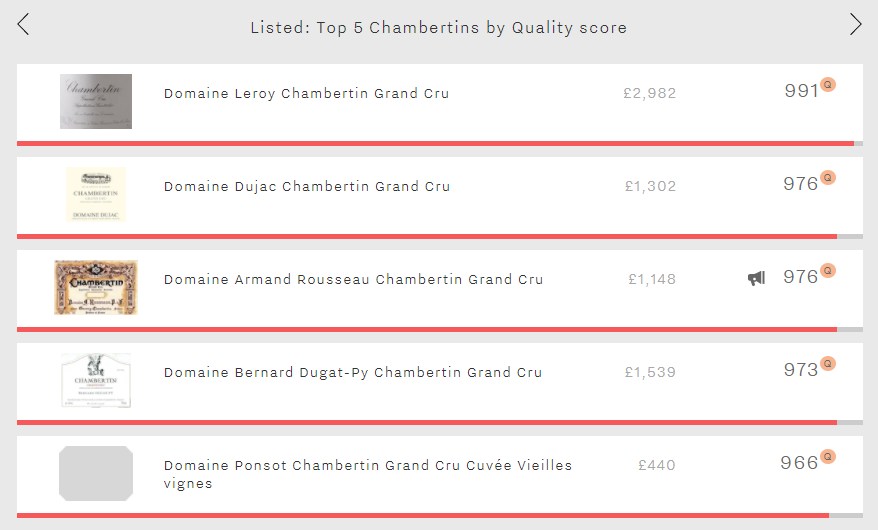
Leading the way with a score of 991 is Leroy’s offering. This exceptional score is the third-best Quality score on Wine Lister and the highest of any red wine (alongside DRC La Romanée-Conti). Across all vintages, it receives near-perfect ratings from Wine Lister partner critics Jancis Robinson and Jeannie Cho Lee (19.5/20 and 99/100 respectively). Moreover, Jeannie Cho Lee awarded a 100 point score to the 2015 vintage. But with the longest ageing potential of the group – over 18 years on average – the 2015 will reward patient drinkers, and with a wine-level average price of £2982 per bottle, you would want to savour it at its peak.
Next come Dujac and Rousseau’s offerings with scores of 976. Whilst these wines achieve identical Quality scores, and similar Economics ratings (951 and 979 respectively), the Rousseau achieves a far superior Brand score (960 vs 608). In fact Rousseau’s Chambertin convincingly outperforms the others in the Brand category, which achieve an average score of 638. The chart below confirms that Rousseau’s Chambertin enjoys far greater brand recognition than its Quality score would suggest within this set of peers, definitely earning its Buzz Brand status.
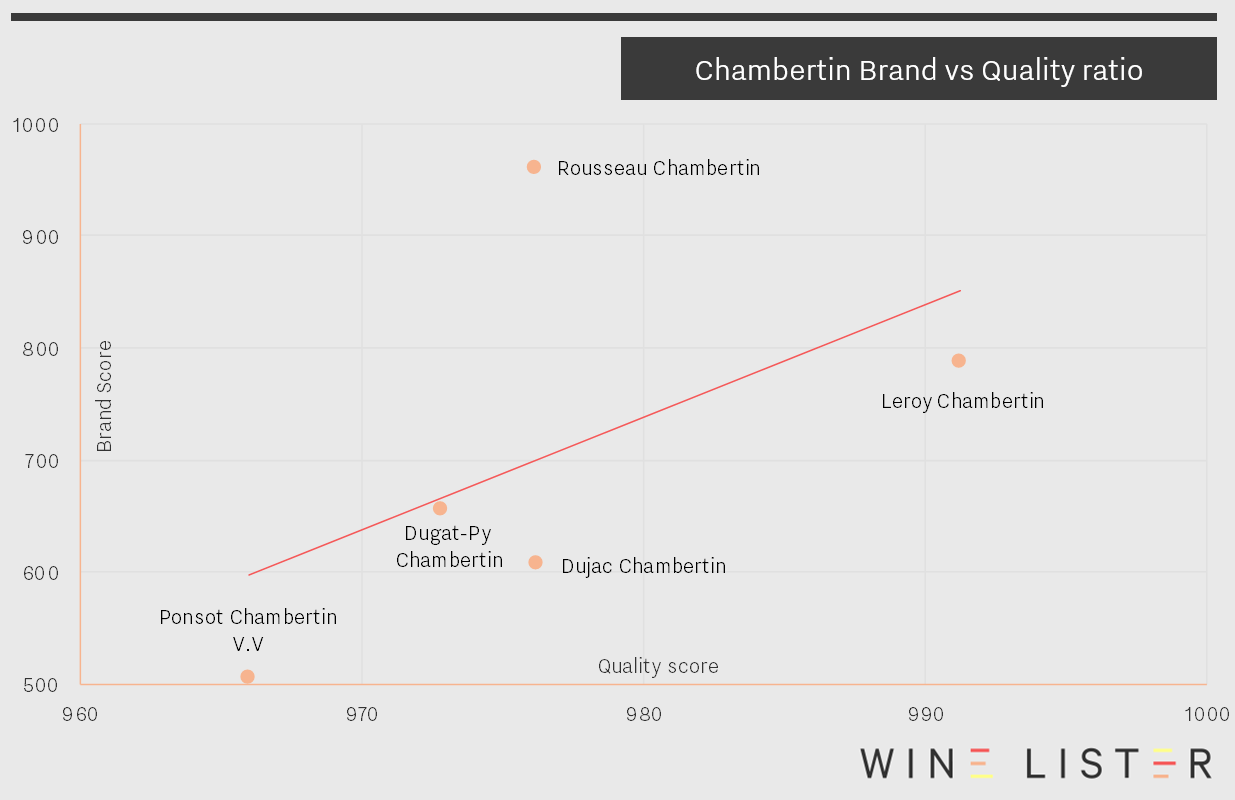
In fourth place is Dugat-Py’s Chambertin (973), just seven points ahead of Ponsot’s Chambertin Cuvée Vieilles Vignes (966). Despite their similar Quality scores, there is a noticeable difference in their prices, with the Dugat-Py the second most expensive wine in the group (£1539), whilst the Ponsot is by far the cheapest (£440) and looks relatively good value. If we look a little further, Ponsot Chambertin 2007, with a Quality score of 968 is currently available for as little as £399 per bottle and is in the middle of its drinking window, making it an excellent proposition for that seasonal treat.
If you are interested in Burgundy and its position in the fine wine market, then watch this space for our forthcoming in-depth regional study, due to be released in January.
As we edge ever closer to Christmas, it feels appropriate to take a look at sweet wines. Here we consider Alsace’s top 5 sweet whites by overall Wine Lister score. Produced in a thin sliver of land in the far East of France, Alsace’s top sweet whites are separated by just nine points (less than one hundredth of Wine Lister’s 1,000-point scale!). The five wines display very similar profiles, all outperforming in the Quality category, achieiving middling Brand scores, and trailing economically.
Four break the 900-point boundary in terms of Quality scores, putting them amongst the very top quality wines on Wine Lister. Hugel et Fils Riesling Vendange Tardive (VT) falls just short with 881 points, still a very strong Quality score (thanks to 17/20 from both Jancis Robinson and Bettane+Desseauve, and 92.5/100 from Vinous). The same producer’s Gewürtzraminer VT scores even higher for quality (910) thanks to a 95/100 from Jeannie Cho Lee:
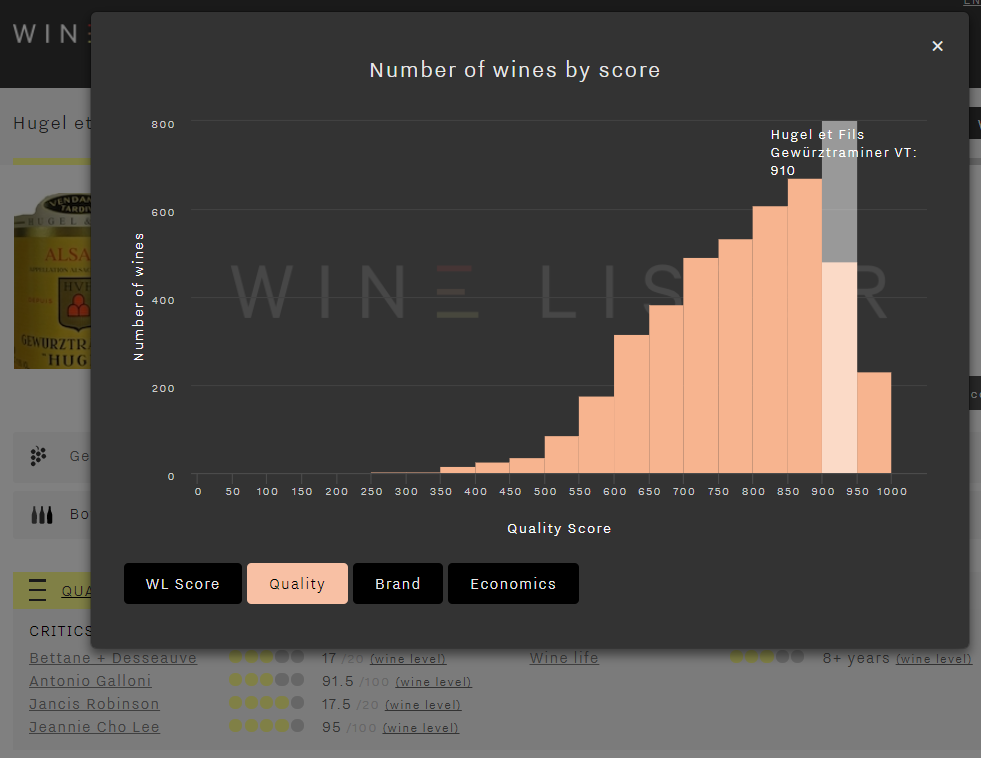
Moving categories, scores drop sharply from an average Quality score of 915 to 550 for Brand – still above the average for all wines on Wine Lister:
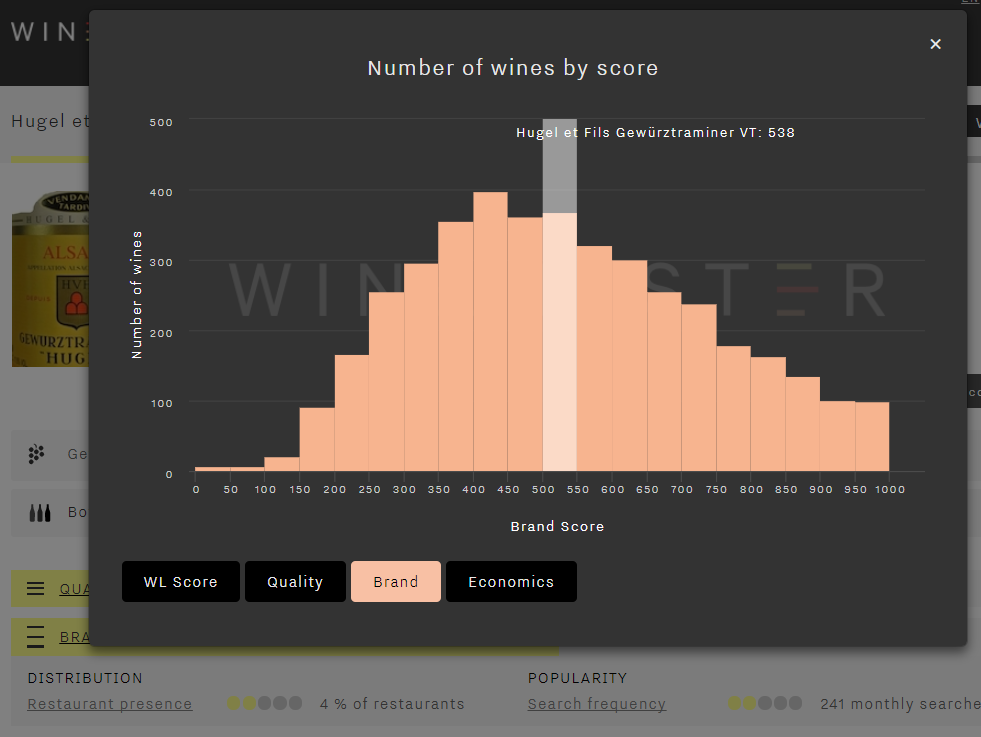
Economics scores trail even further behind, averaging 338, hindered by low liquidity. For example, Hugel’s Gewürtzraminer VT failed to trade a single bottle at auction over the past four quarters (as measured by Wine Market Journal). The chart below shows Economics score in the context of all the wines on Wine Lister – its is well below the average, with a score below 400 putting in the “weak” score band:
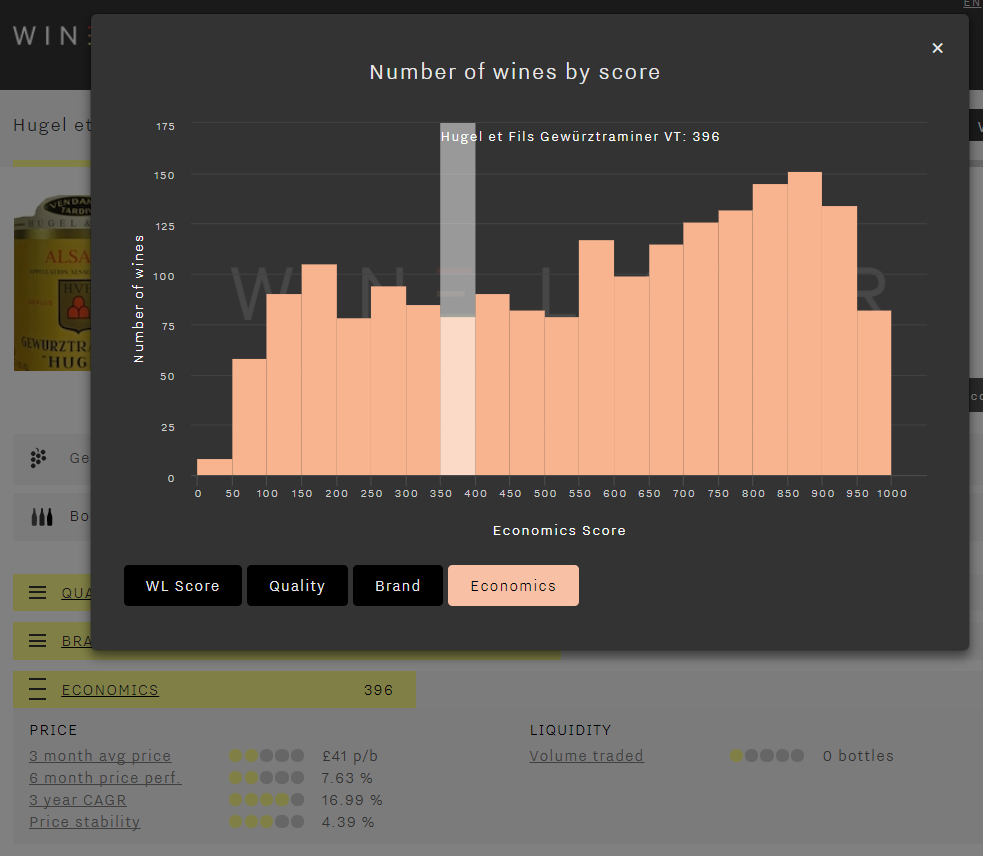
Other wines making the top five are Zind-Humbrecht Jebsal Pinot Gris VT (675) and Trimbach Gewürztraminer VT, which achieves the best restaurant presence of the group. However, featuring on just 6% of the world’s best restaurant lists, this suggests that Alsace’s sweet whites are not every sommelier’s must-list bracket, even when produced by the region’s most famous producer. Incidentally, Trimbach’s Clos Sainte Hune appears in 34% of wine lists (compared to 69% for Sauternes’ Château d’Yquem).
The last wine making it into this week’s Listed section is Marcel Deiss Altenberg de Bergheim Grand Cru. The only non-single varietal wine of the group, it is a blend of 13 different varietals planted in the same plot, and is by far Bettane+Desseauve’s preferred wine of the group – the French duo award it an average score of 19/20. It is also the most popular wine of the group. However, its modest average search frequency (380 per month on Wine-Searcher) confirms that Alsace’s sweet whites currently fly well under the radar.
So, when you’re stocking up your cellar for Christmas, give Alsace’s sweet whites a go. They might not be the most prestigious, but the quality is there and prices are pleasing.
The latest three-month average search frequency data is in, and with it we can see which wines’ increase in popularity has boosted their Brand score. Here we focus on the five wines that saw the largest increase. All saw at least a 29-point rise in their Brand score.
Château Montviel saw the greatest increase, gaining 60 Brand points and taking its overall Wine Lister score to 523. Its average monthly search frequency of 1,085 remains its strongest criterion score, as its three-month average price (£31) and liquidity hold it back — it has failed to trade a single bottle at auction over the past year.
The second-highest increase was Campo Eliseo, whose Brand score rose 37 points to 453. Although it holds the lowest overall Wine Lister score of the group (490), it had the greatest surge in online surge frequency (+64%).
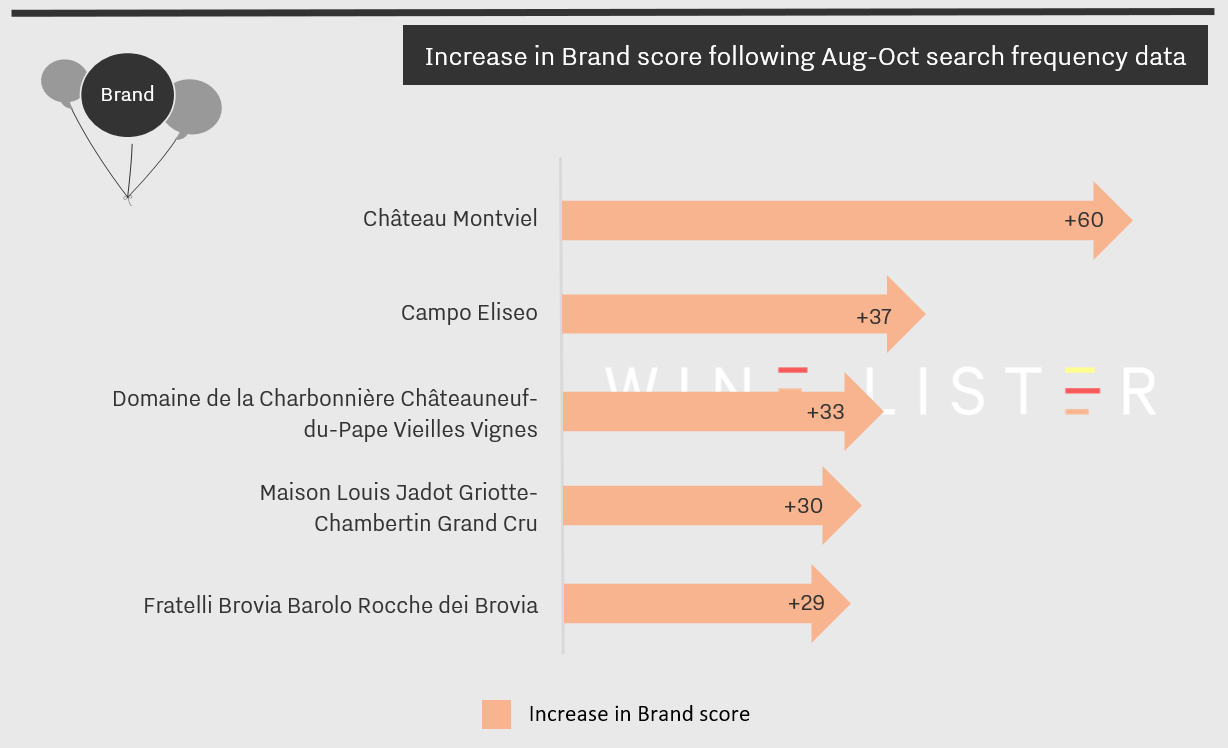
Following a drop in its price over the last six months, Domaine de la Charbonnière Châteauneuf-du-Pape Vieilles Vignes also saw a welcome increase in search frequency (+51%) and a subsequent Brand score increase of 33 points to 437, pushing its overall score towards the ‘Strong’ band on the overall Wine Lister scale (now just 17 points short at 583).
The fourth-highest increase, though still the with the lowest overall search frequency of the five (172 searches), is Maison Louis Jadot Griotte-Chambertin Grand Cru. Currently holding Hidden Gem status, is this an early sign that this wine won’t be under the radar for much longer?
Finally, Fratelli Brovia Barolo Rocche dei Brovia saw an increase of 29 Brand points to 654, following a 45% increase in search frequency. US partner critic Antonio Galloni rates it very highly, with the result that it achieves the highest overall Wine Lister score of the group (702).
So, with an impressive 10% increase in its Brand score this month, Château Montviel is the one to watch as we move in to the winter months.
For this week’s top five, the spotlight is on our highest ranked Spanish red wines. All achieve a total Wine Lister score of over 913, yet there is a significant price difference between the lowest and highest priced bottle (over £500).
Vega-Sicilia Unico wins the Spanish sprint to the top spot with an applaudable Wine Lister score of 971. With impressive restaurant presence (47%) and over 17,000 average monthly searches, the wine’s Brand score is a big contributor to its number one spot.
Next, scoring 47 points less (923) though more than double the price (£573), is Pingus. With consistently high ratings from Jancis Robinson, Jeannie Cho Lee and Antonio Galloni, it has a very strong Quality score of 936 – identical to its Brand score.
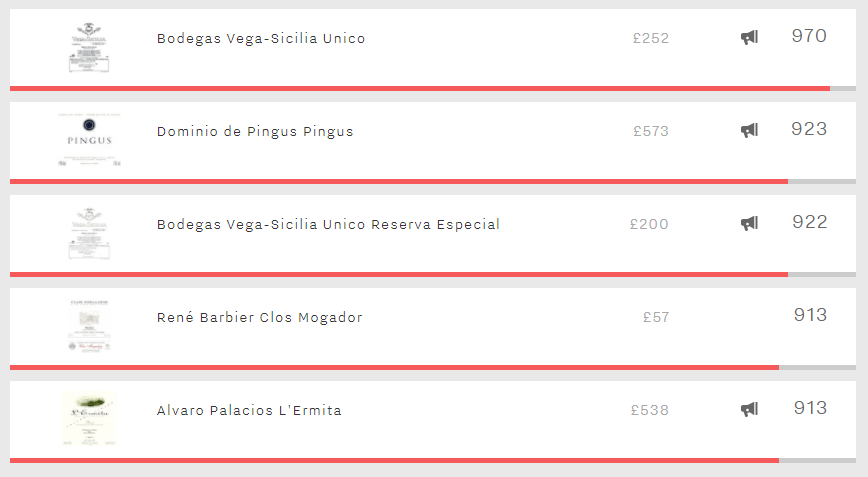
A second wine from Spain’s most prestigious wine estate, the Vega-Sicilia Unico Reserva Especial, comes in third place with the highest Quality score of the group (983). However, similar to all the other top five’s, its price has been decreasing since August.
The most affordable wine of the group is the René Barbier Clos Mogador, at £57 per bottle on average. It’s the only wine of the five not to hold Buzz Brand status, though it scores five out of five for liquidity, with 300 bottles of its top five vintages traded in the past year.
Joint fourth is Alvaro Palacios L’Ermita, matching Clos Mogador’s Wine Lister score of 913. Its three-month average price scores four out of five — an improvement on its six-month price performance of two out of five. It’s the rarest in its peer group, producing just 1,350 bottles per year on average, though it still manages to achieve 19% restaurant presence.













